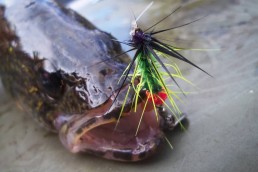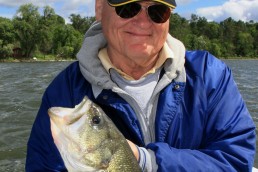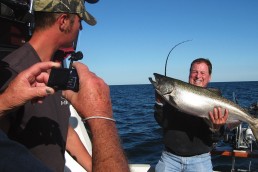The Tale of a Fishing Innovation that Entices ‘em All: Part Three
SHARE THIS POST
“Bobber” Anne and I had already realized that our new creation was a winner. Not just on rough fish, as was previously described in the past two articles, but on all gamefish, both freshwater and saltwater. During early summer of 2015, we concentrated on trout, salmon and several predator species.
However, before getting into these I’d like to bring out the affect this fly has on bass, especially smallmouths. No lure I’ve ever created or have used has brought out a smallie’s striking instincts like this new fly/lure. I believe it’s because of the spinner and its ability to attract fish.
Long ago, when my father requested his 14-year-old son (me), create a tail-spinnered fly we called the “Flub Dub,” my confidence in the ability of a spinner’s enticement has remained strong. The first spinnered fly was created to entice brook trout in the Nipigon River of Ontario. As I’ve stated in previous articles, not only was it a success on trout, but also when introduced in the states as a panfish fly.
During our research of the river Benthic Zones back in the January, February and March 2016 issues of MidWest Outdoors, Anne and I were bombarded by smallmouth strikes while filming under water. Proof was obtained on film: When these bass refused to feed it really came down to the flash of the tail-spinnered lure. And, more river bass than any other species were captured on this new lure.
Once under a late-day sun on a central Wisconsin lake in September 2014, “Bobber” Anne tied on a Black number 1/0 Silver-tail-spinnered fly. Her intent was to entice one of the lake’s largemouths. As always, a number 5 split shot was pinched on 10 inches ahead of her fly/lure. On her third cast, the medium-action spinning rod rammed downward as a fish struck. Not a bass, but instead, a muskie.
Using only 10-pound-test mono, the battle lasted 10 to12 minutes. It came into the net and was landed.
“How about that?!” Anne exclaimed.
Yes, how about that? The 4-inch fly had produced a fish normally associated with 10- to 14-inch lures. Why had this happened?
My assessment credited the muskie strike to the flash of the Silver blade-spinner. Usually the Black has always been a great color for this fish.
But that fish wasn’t the only predator our new fly had taken. Several large northern pike had fallen prey to it. I took one out of Leech Lake in northern Minnesota in June that fell for a 1/0 yellow Flick Fly used on a fly rod. In Ontario on the Ogoki River, four pike, including one of respectable size, gathered to us when we used our fly/lure. My quest at that time had been walleyes on a fly rod. The fly color was brown and yellow to imitate a perch or dace. (For pike/muskies on a fly, use 10-pound-test “SILVER-LUS” Monel Wire Line by Mason Tackle Company or similar line, as this wire prevents cut-off by toothy fish.)
Spring 2015 was exciting, and after the Cleveland Sports Show in Ohio, Anne and I had a chance to present our new fly/lure to the steelhead run. Our longtime friend Donny Schonauer led us to a small stream full of ‘‘steelies.” Egg sack flies had always been the bait of the day. But all that changed when those wary fish were given a look at a number 8 spinnered fly in a nymph pattern. Once again, we tipped the fly with a Red Ball Egg.
Anne was the first to lay the new fly in front of a pair of nesting steelies. As the fly drifted downstream, the pair of male steelheads darted out, grabbed the nymph-style fly and raced off. Anne was in full pursuit then, as water sprayed upward as she waded and engaged surface water.
I targeted the female with a similar result. As my nymph-style fly drifted to within 8 inches of her nose, she nudged forward and engaged. Like my partner, I too was hooked to an 8-pound tornado that followed the path taken by her mate. We had landed the pair on a sandy beach next to a large pool half a block downstream. Here, hordes of steelheads were pairing up to make the block-long migration up the fast-water gravel area.
During that day on the Grand River the two of us caught and released 23 steelhead, with the largest estimated at over 10 pounds. Besides that, we had convinced Donny to replace his special egg sack fly with our new nymph-style tail-spinnered fly.
Then, there was the trip we made to my old fishing grounds on the world-famous Nipigon River to seek out the brook trout.
Are you enjoying this post?
You can be among the first to get the latest info on where to go, what to use and how to use it!
Ray Dupuis, a dear old friend, led our group.
“Dan—we’ll hit the ‘overflow’ first,” Ray suggested. “It’s been producing some really good speckled trout on your Dad’s Muddler Fly.”
The ride to the overflow took 30 minutes after our launch at the Pine Portage dam on Hanna Lake. After tying our boat off below the overflow, we then walked up to where we’d fish off the shoreline.
Anne was first, and three casts into her presentation a 2-pound brookie slammed her Brown Creeper nymph-styled fly. Because the fish was smaller than expected, Anne was told to go for it again. She did, and a 3 1/2-pound brookie landed a few casts later.
I was next, and a 6-pound brook trout fell for my number 8 Muddler-styled fly.
From then on, it was everyone for his or herself.
In the end, we caught and released 19 brookies from the fast, heavy-flowing waters of the Nipigon overflow. Seven of these exceeded 4 pounds.
The next day, we fished the Virgin Falls area of the same river and caught 14 trout. Though the count was lower, the weight was heavier. Two of the brookies at Falls exceeded 7 pounds. These brook trout were monsters and all were caught on our new fly.
To entice the trout, we added a number 8 split shot 8 to 9 inches above the fly. Instead of presenting the fly up the current, or crosscurrent, as is normally done, most of our casting presentation was down current or at an angle semi-downstream. Thus, the fly’s tail spinner worked and flashed all the time.
Naturally, I used a Muddler-style tail-spinnered fly at Virgin Falls. It was here that my father created the world-famous Muddler Fly in 1936.
During this part of the series on our new Flick Fly, we’ve concentrated on the fly’s ability to catch rough fish. This is due to my excitement the fly brings, and the beginnings of it on a whole new fishery.
Over the three years of testing, we had caught salmon in Lake Michigan, out of the port of Waukegan. Both kings and cohos were caught using the 1/0 streamer-style fly when this fly was hooked up to our downriggers. Peacock bass were also taken on the new 5/0 experimental fly in spring 2015 in the Upper Amazon River of Brazil. Off the coasts of Florida, the experimental fly took blackfin tuna, bonita, dolphin and barracuda. These fish eagerly attacked this fly when it was trolled rapidly behind our boat. Each of us had a chance to work a 9-weight, 9-foot, heavy-duty fly rod on these saltwater fish.
Trolling has also been applied as the best method to present the lure. Research proved that 50 percent more fish were taken when trolling the Flick Fly. It’s our conclusion that a trolled fly allows all species a longer follow time, therefore a longer time to size up the lure before striking. “Bobber” Anne’s underwater video showed this fact time and again.
Of course, as usual, more research is needed. When more information is ready, we’ll follow it up and give it to you.
MWO
SHARE THIS POST
Did you enjoy this post?
You can be among the first to get the latest info on where to go, what to use and how to use it!
Dan Gapen
Considered one of the world’s leading river anglers, Dan Gapen, Sr. has shared his knowledge with MidWest Outdoors readers and viewers for more than 40 years. He is a member of all three Fishing Halls of Fame—International, National Freshwater, and Minnesota. He has an immense grasp of the world’s fisheries. He may be contacted at 877-623-2099.
@TheGapenCompany.



